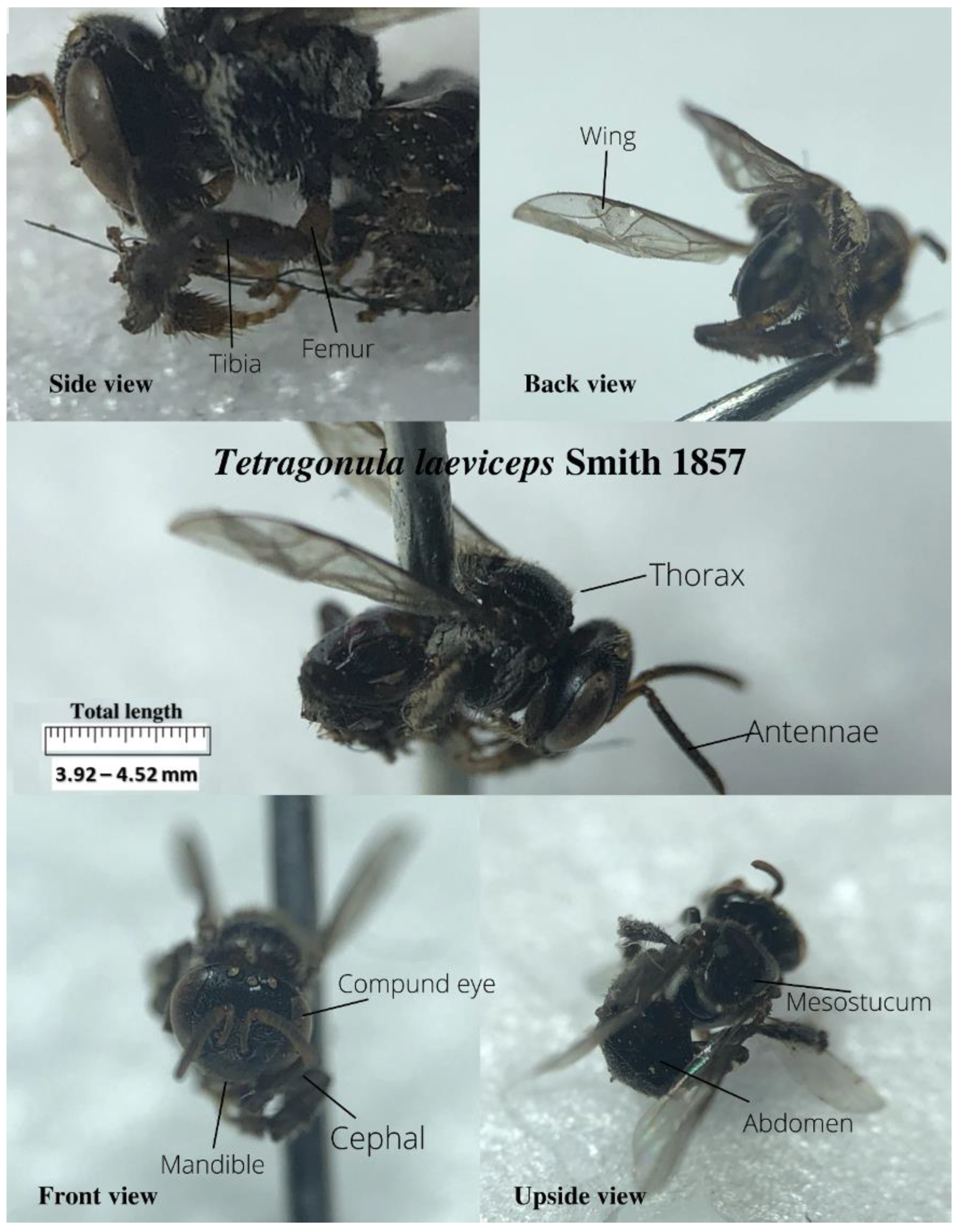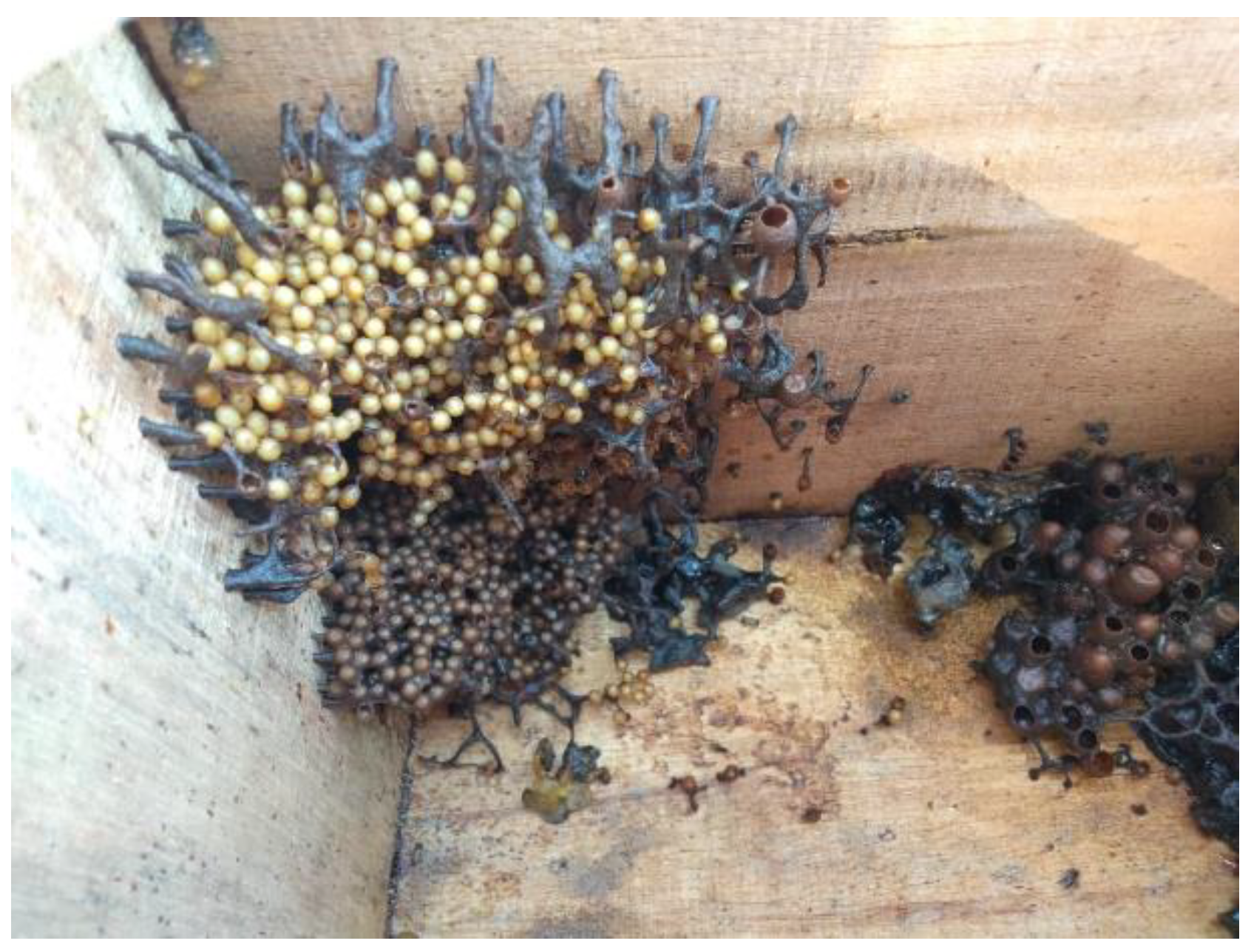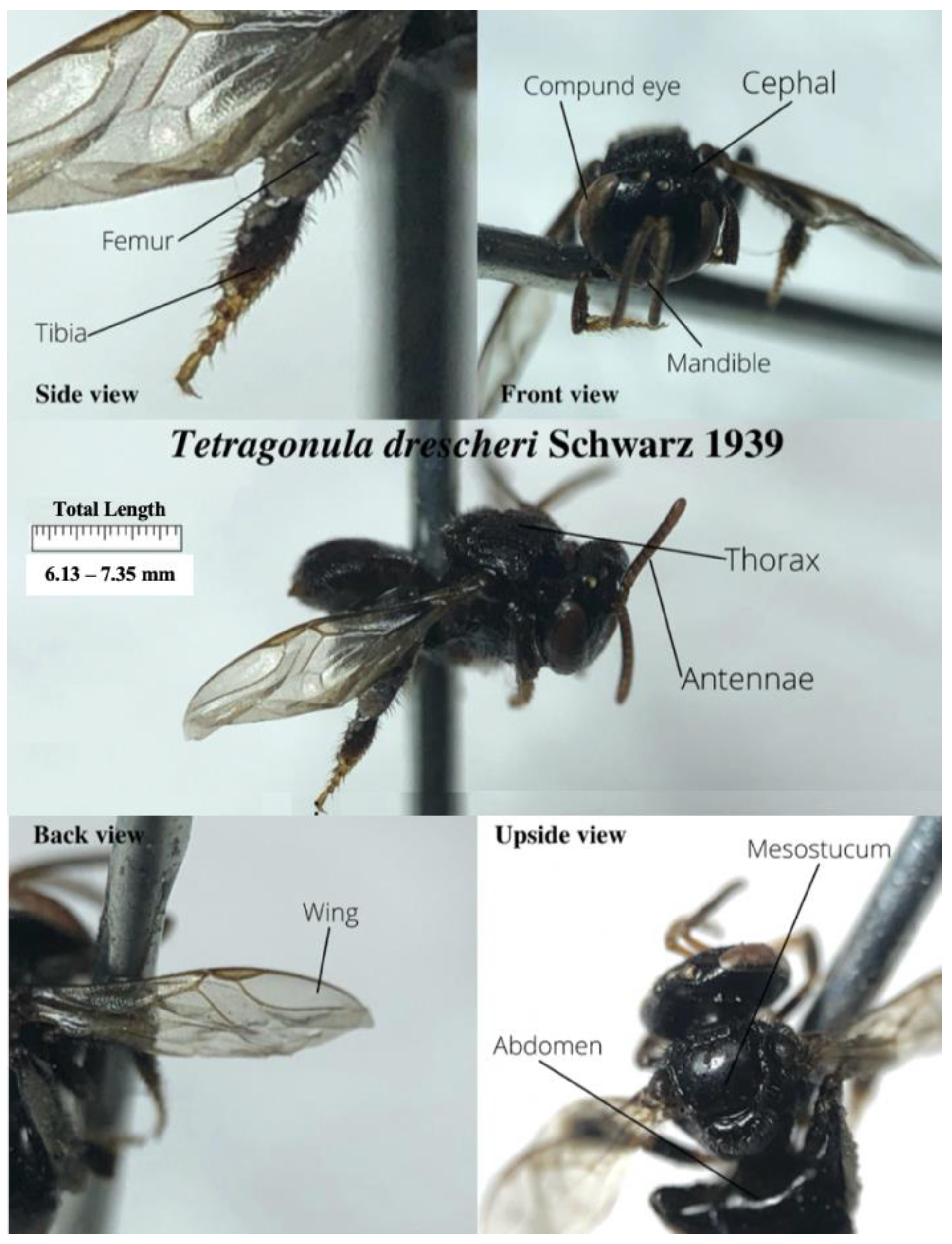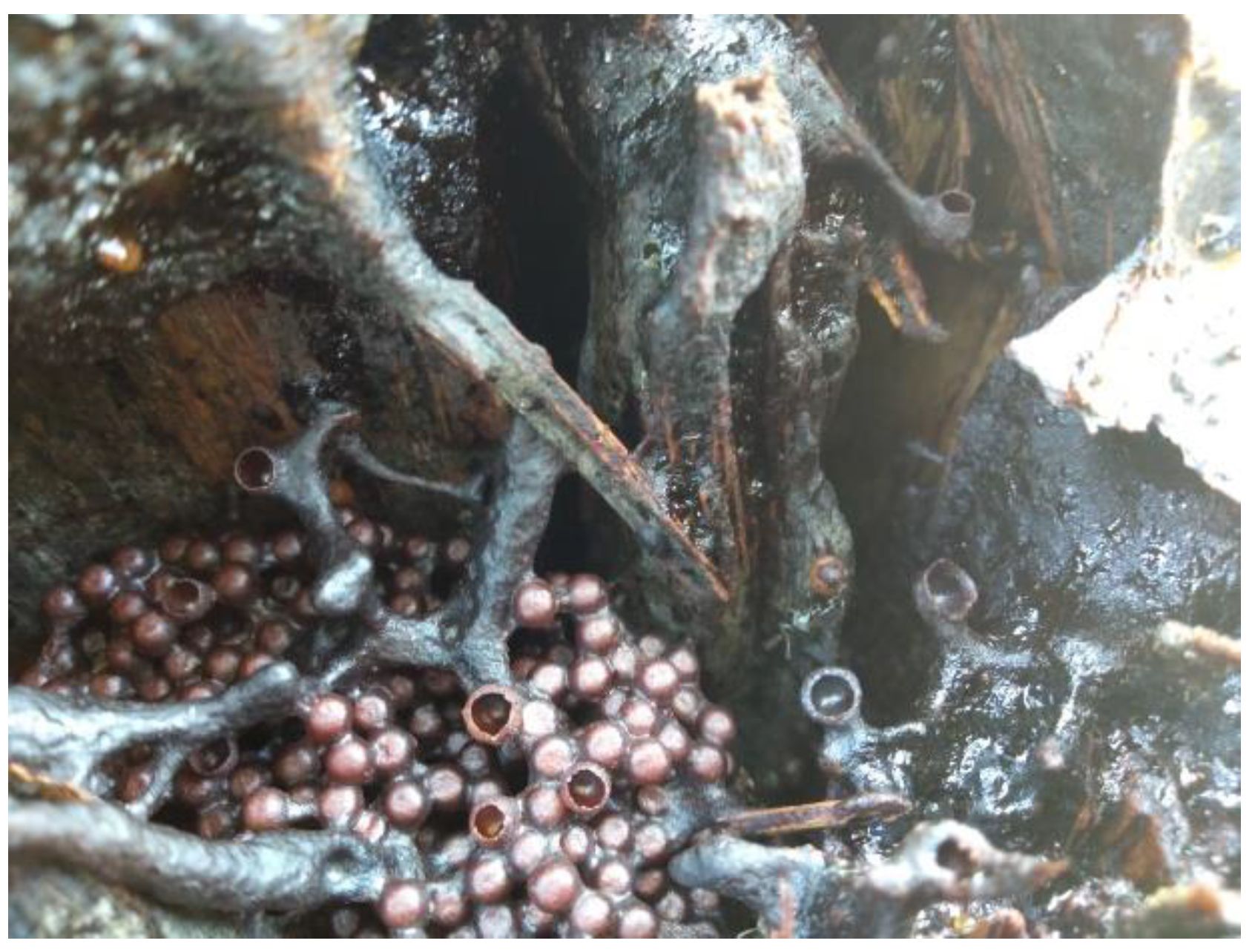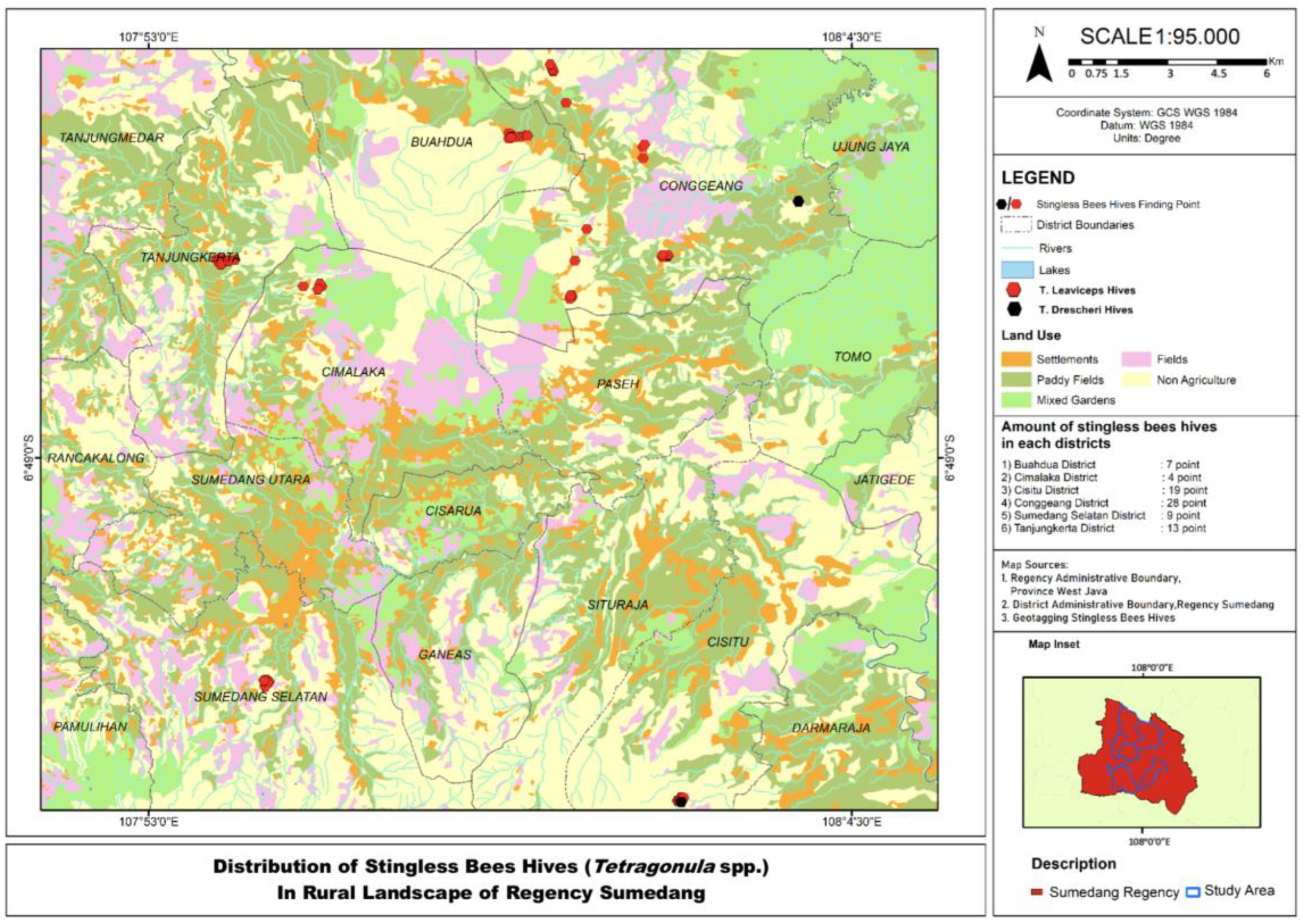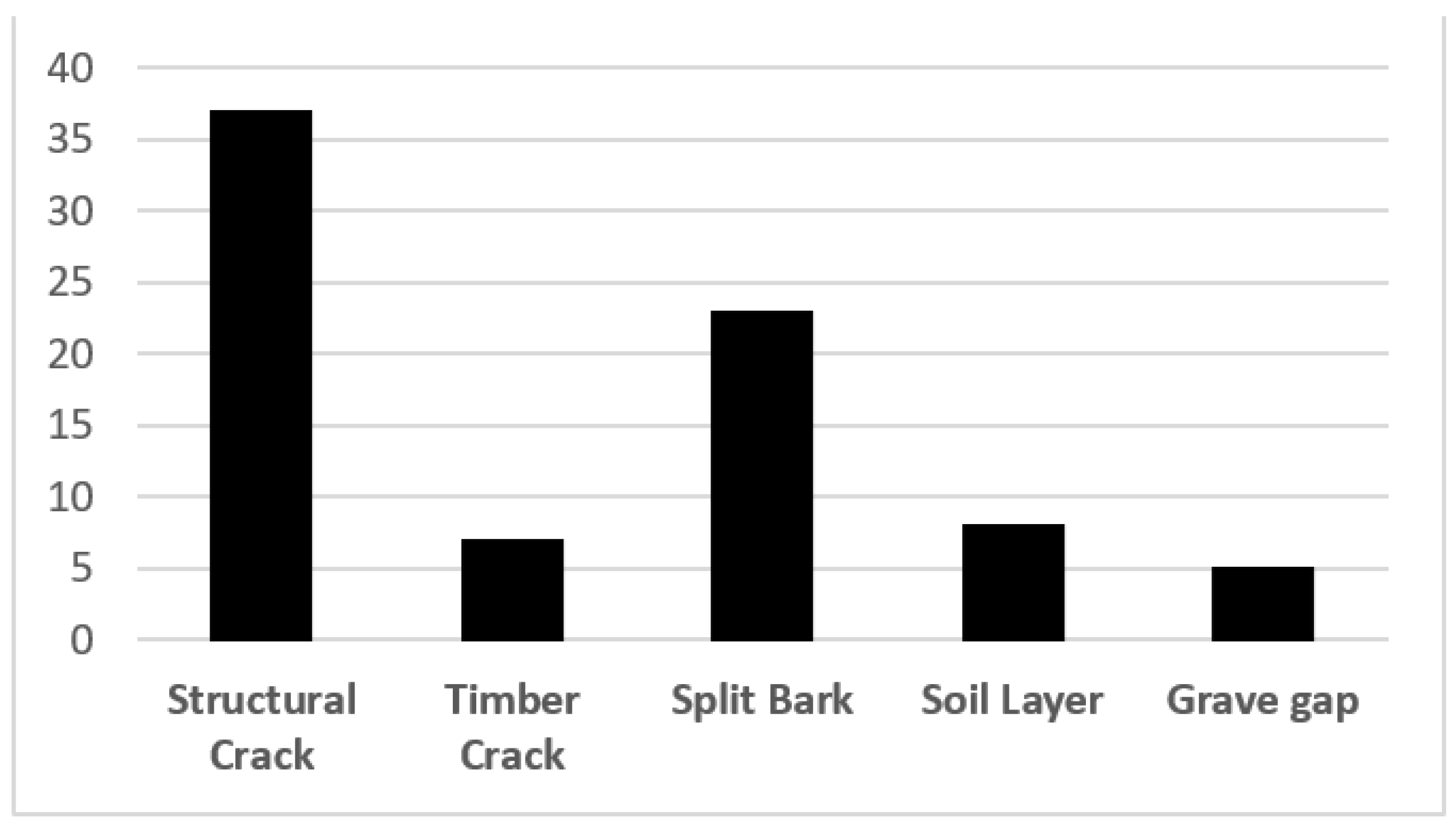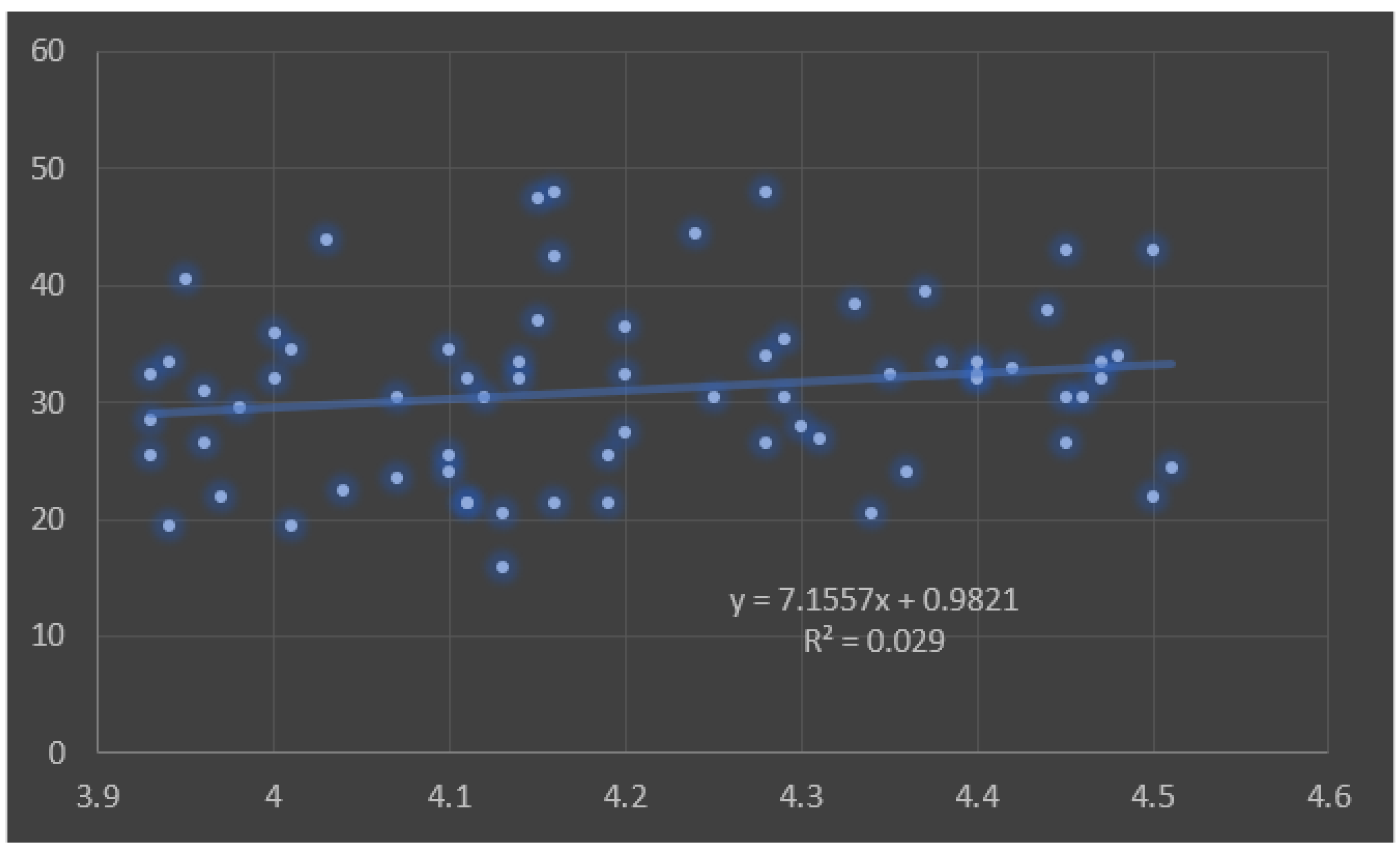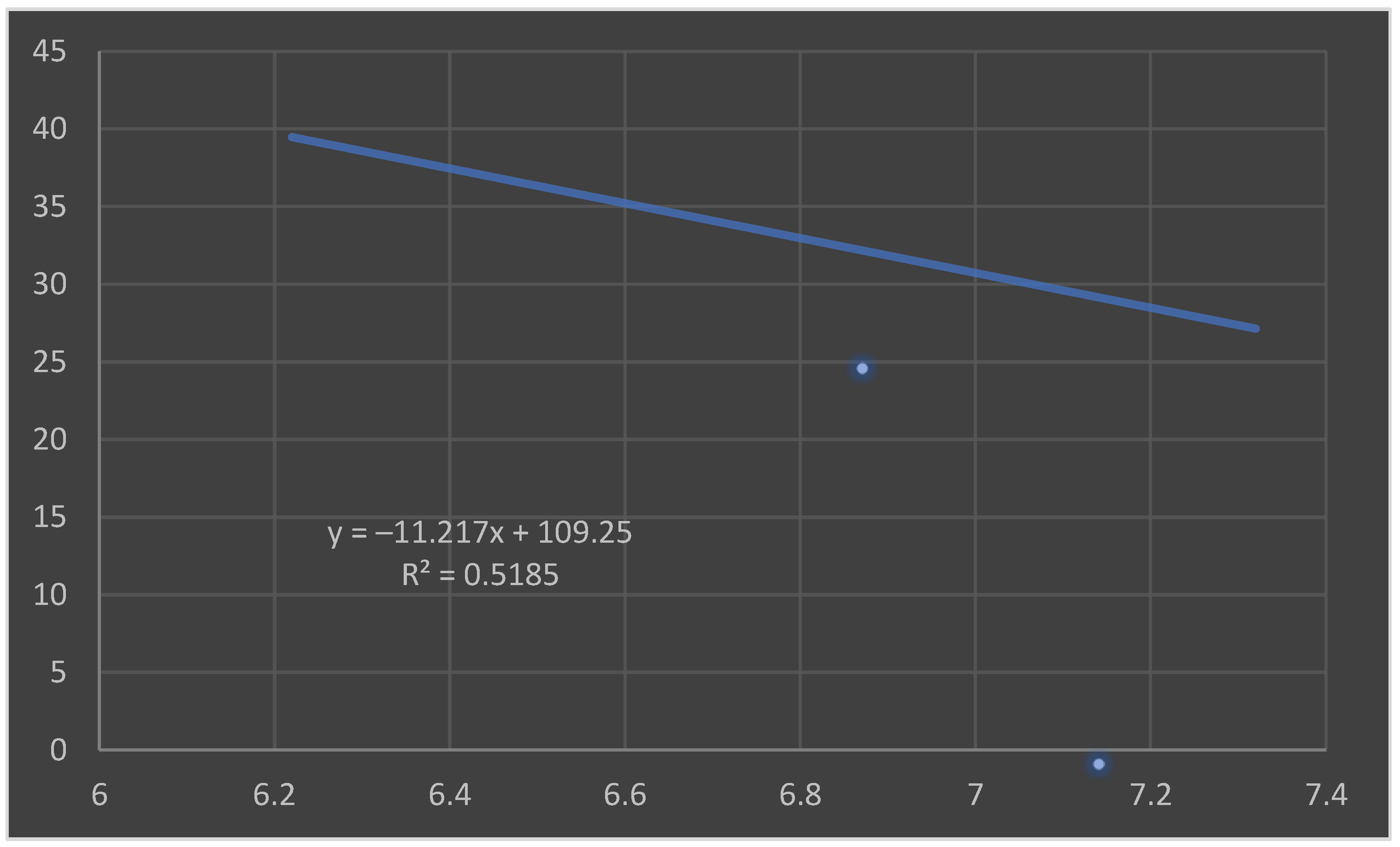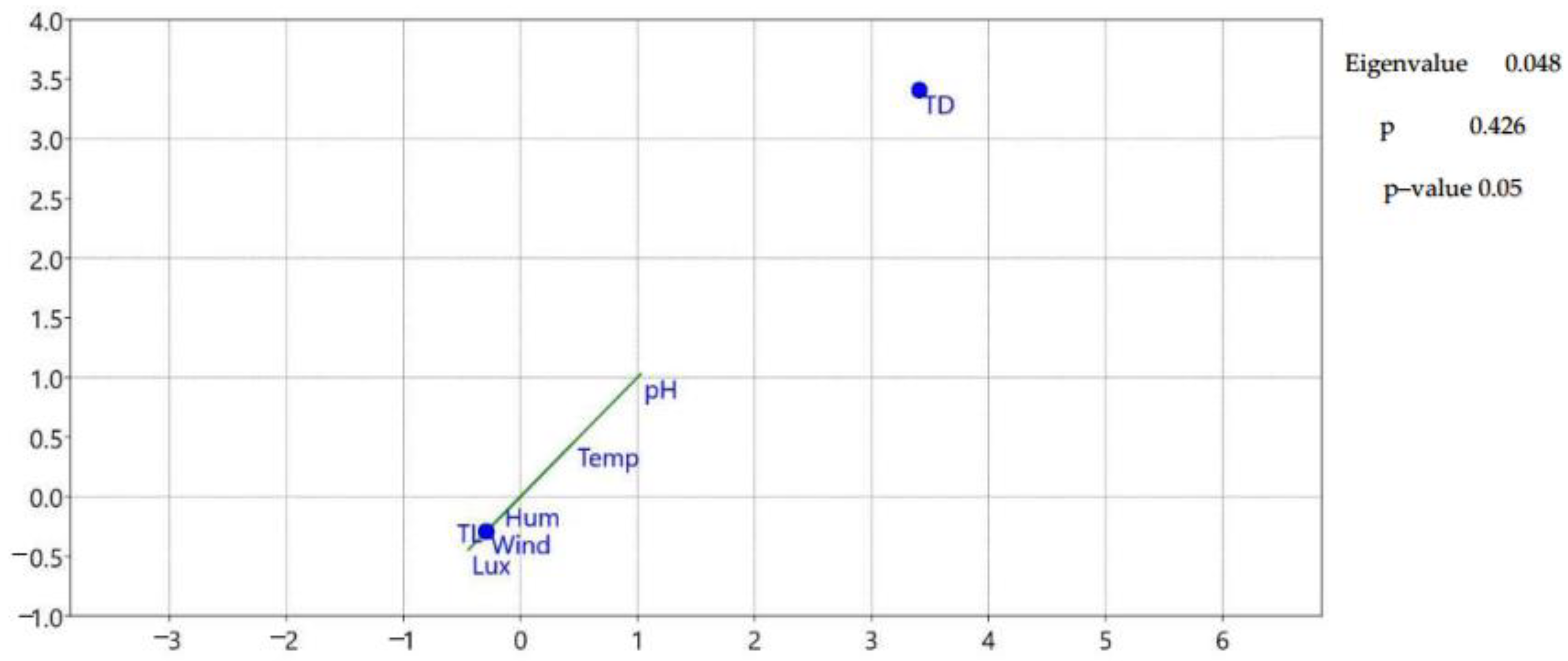3.1. Classification and Distribution of Tetragonula spp.
Information gathered from bee hunters and communities advised the researchers that there was one species of stingless bee in the study area: Tetragonula laeviceps Smith. However, reports from BRIN on the data obtained from searches conducted in six sub-districts in Sumedang Regency showed that there are actually two species of Tetragonula in the region: Tetragonula laeviceps Smith and Tetragonula drescheri Schwarz. The former was found at 71 meeting points in six sub-districts, and the latter was found at 9 meeting points in five sub-districts.
Table 1 [
24] shows the classical morphological identification of the two species by BRIN:
Tetragonula laeviceps purportedly exhibits a heightened level of resilience compared to its congeners within the
Tetragonula genus, as substantiated by its capacity to endure regions characterized by limited nutritional resources and climatic conditions of an extreme nature [
25].
Tetragonula drescheri is distinguished from
Tetragonula laeviceps by the presence of brownish-yellow fine hairs on the mesoscutum, the presence of a black line under the metafemur, and the blackish-brown color and yellow spots on the metatibia [
26].
Table 2 shows the differences between the two species from the beehives found in the study area.
Table 2.
Differences between the two species from the beehives.
Table 2.
Differences between the two species from the beehives.
| Tetragonula laeviceps Smith | Tetragonula drescheri Schwarz |
|---|
| Red-colored honey sac and pollen sac ( Figure 4).
|
The construction of hives by this particular genus of bees is facilitated by the secretion of saliva resulting from metabolic processes within their bodies. Consequently, the physical variations can be identified through the outcomes of its metabolic processes, specifically the structural features observed in the beehives, such as the hive walls, pollen sacs, and honey sacs.
Tetragonula colonies were found nesting in a variety of different substrates, the full details of which are presented in
Figure 5 below.
Based on the results of our field observations, wild
Tetragonula spp. colonies were found in a variety of natural and artificial substrates. The natural characteristics of stingless bees show that they prefer to build hives in bamboo trees, wooden walls, and iron cavities [
11], rendering them more adaptive when building hives. The complete data on the hive substrate are presented in
Figure 6.
Tetragonula laeviceps is the most commonly distributed species found in Indonesia. This is strongly influenced by
Tetragonula laeviceps’ ability to adapt to and survive in extreme weather conditions, especially the tropical climates of Southeast Asian countries [
27].
Tetragonula laeviceps is also frequently found in other Southeast Asian countries, such as Malaysia [
28]. However, during the field observations, it was difficult to find
Tetragonula drescheri.
Tetragonula laeviceps was the most commonly observed species and was found in various categories of substrates (
Figure 7). The bees could be found building their nests in building and rock crevices and in building foundations.
Based on our empirical observations, it was determined that
Tetragonula spp. beehives predominantly occupied building cracks and tall plant cavities, along with other substrates such as soil layers, gaps in wooden structures, and burial sites. This finding aligns with the assertion made by reference [
29,
30], which suggests that the majority of
Tetragonula spp. were observed in forested areas, although certain species were discovered in human dwellings, tree hollows, and other suitable cavities that could serve as prospective nesting sites. In tree hollows, these bees were often found building their nests in bamboo cavities, especially bamboos with large hollows, such as
Awi surat (
Gigantochloa verticilata) and
Awi tali (
Gigantochloa apus). However, few
Tetragonula spp. colonies were found in bamboo clusters around the observation fields. This might be due to the high demand for stingless bee colonies, as a result of which many local residents sought out the bee colonies and removed them.
Based on field observation, in addition to bamboo trees, stingless bees can also be found on Teureup trees (Atrocarpus elasticus), mahogany (Swietenia mahagoni), Kapuk (Ceiba petandra), clove (Syzigium aromaticum), Melinjo (Gnetum gnemon), coconut (Cocos nucifera), snake fruit (Salacca zalacca), coffee (Coffea sp.), Tisuk (Hibiscus macrophyllus), and Jengkol (Pithecelobium pauciflorum). Colonies of Tetragonula laeviceps can be found in tree trunk cavities and tree root cavities, which are covered with soil. Additionally, Tetragonula laeviceps can also be found nesting in soil layers in residential areas, plantations, and forests. Tetragonula drescheri can be found nesting in soil layers, building crevices, and rocks in both forests and residential areas.
Field observations also led to the discovery of other colonies within a range of 10 m or in close proximity to each other at the same location. This was possible because stingless bees prefer to build colonies in viable crevices. The presence of colonies is also influenced by the availability of food and environmental factors. The size of a bee colony is influenced by the species, the age of the colony, the size of the hive, and other environmental factors such as temperature, humidity, and altitude [
12].
The findings from our field observations indicate that in a given colony discovery location, there was a tendency for two to six Tetragonula laeviceps colonies to be frequently found in close proximity to one another within a 10 m radius. Moreover, it was observed that these colonies had a preference for constructing their hives in the same substrate. Furthermore, a substantial quantity of colonies, ranging from 11 to 17, were seen at a single geographical site. The evidence presented indicates that Tetragonula laeviceps exhibits considerable potential for population growth through the establishment of further colonies. Moreover, their adaptability is evident, as they are capable of thriving in many substrates. In contrast, a limited number of Tetragonula drescheri colonies, ranging from one to three, were observed in immediate proximity to one another within a 10 m radius.
The findings from the field studies indicate that there was no spatial proximity seen between colonies, including two distinct species of Tetragonula spp., within a 10 m radius. This phenomenon could potentially be attributed to interspecific rivalry among the Tetragonula species, indicating a spatial separation of hive colonies.
In addition to the number of colonies found, other supporting data, such as the direction of the hives and the category of substrates, were collected at each location. Among 80 Tetragonula spp. colony locations in six sub-districts, it can be seen that the colonies were placed at an altitude of 303–892 m above sea level, and the surface slope was approximately 1–30%. This is because the geographical conditions of the six sub-districts of Sumedang Regency are different.
Another conclusion that can be drawn from the results is that
Tetragonula spp. can be found in moderate to high land conditions. The land area boundaries can be divided into three classes, namely lowlands (0–299 m), medium plains (300–699 m), and highlands (≥700 m above sea level) [
31]. Both species were found in moderate-to-high-altitude conditions. From the results of the field observations, we can see that
Tetragonula spp. colonies were found at elevations of 0–457 cm above the ground. Elevation is one of the factors that influence insect diversity because altitude can affect the insects’ lifecycle and growth. Insects grow more slowly in areas with lower temperatures at higher altitudes compared to areas with high temperatures at low altitudes [
32].
Another factor influencing the presence of
Tetragonula spp. colonies were water sources in proximity to the hive. Water is an important factor in the metabolism of living things, and it is also an important component of the honey produced by
Tetragonula spp. According to [
33], honey contains various kinds of molecules, such as glucose and fructose (80–85%), water (15–17%), and protein and amino acids (0.1–0.4%). Stingless bee honey has the characteristic of being thinner than
Apis honey and is amber brown in color. The taste of this honey tends to be more acidic because it has a pH of 3.05–4.55, and the water content of this kind of honey is higher (around 30–35%).
3.2. Characteristics of Tetragonula spp.
Each type of stingless bee has its own hive-building characteristics and patterns of activity.
Tetragonula spp. beehives are characterized by various entrance shapes, such as funnel-shaped and irregularly rounded entrances or those without a protrusion at the entrance [
34].
From our observations, it was found that the Tetragonula spp. beehive entrances varied widely between species. Tetragonula laeviceps had a hive entrance length ranging from 1 to 21 cm, while Tetragonula drescheri had a hive entrance length ranging from 1 to 7 cm. The length of the entrance to the hive can also be used as a basic tool of identification to determine the lifespan of the colony and how long it takes to build a hive in a given place. The longer the lifespan of the colony and the time taken to build the hive are, the longer the hive entrance will be.
The Tetragonula spp. beehive entrances found during the field observations had a fairly high level of diversity. External disturbances, such as weather and predators, greatly affect the state of the hive entrance. However, worker bees were always swift and adaptive in rebuilding the hive entrance according to the colony’s needs and circumstances.
The shape of the entrance constructed by bees from the genus
Tetragonula spp. is mostly in the form of a hole and does not have a funnel shape [
35]. However, in this study, the funnel-shaped entrance of the bees from the genus Tetragonula was frequently found. The entrance to the hive serves not only as a means to enter and exit the hive but also as a marker of the hive [
36].
Each type of stingless bee has different characteristics. According to [
37], the body size of stingless bees affects the size of the entrance. The larger the bees’ body size is, the larger the entrance to the hive will be.
From the field observations, we can observe that the type
Tetragonula laeviceps had a hive entrance width of approximately 4–32 mm, while
Tetragonula drescheri had a hive entrance width range of approximately 4–11 mm. This element is influenced by the individual size of each type of bee. The size of
Tetragonula laeviceps is approximately 1.8–13.5 mm, while the
Tetragonula drescheri bee is approximately 6.13 mm–7.35 mm [
21]. In all types of stingless bees, there are several worker bees that always guard the entrance to the hive in order to minimize disturbance from predators outside the hive. The average hive dimensions of
Tetragonula laeviceps are 31.1 with a standard deviation of 7.5, and those for
Tetragonula drescheri are 33.6 with a standard deviation of 5.7.
The presented graph illustrates a favorable link between the hive dimension and the body size of
Tetragonula laeviceps (
Figure 8). When the body size value is incremented by one unit, the corresponding increase in the hive dimension value is 7.1557 units. Nevertheless, the distribution of data depicted in this graph does not exhibit any discernible pattern. The coefficient of determination, denoted as R-squared, indicates that only 2.9% of the variance in the dependent variable can be explained by the fitted line. This finding suggests that the body size of
Tetragonula laeviceps has a relatively minor impact of 2.9% on the establishment of hive dimension, with the remaining 97.1% being attributed to other variables.
The presented graph illustrates a negative link between the hive dimension and the body size of
Tetragonula dresscheri (
Figure 9). When the body size value is incremented by one unit, there is a corresponding drop in the hive dimension value by 11.217 units. The R-squared value of 51.85% suggests that 51.85% of the variation in hive dimension can be attributed to the body size of
Tetragonula dresscheri. The remaining 48.15% of the variation is influenced by other variables.
In addition to the length and width of the entrance, which characterize a hive, the characteristics of a hive also include the thickness of the hive entrance. The entrance to a stingless beehive is generally formed of resin and propolis, which are found in bee saliva and mixed with mud obtained from the environment around the hive [
19]. From the field observations,
Tetragonula laeviceps has a hive entrance thickness of approximately 1–7 nm, while
Tetragonula drescheri has a hive entrance thickness of approximately 1–3 nm.
The thickness of the hive entrance can also be used to determine how long the colony has been building hives in a given place. The thicker the entrance to the hive is, the longer the life of the bee colony will be. The entrance to the hive of
Tetragonula laeviceps does not contain propolis, unlike those of other
Tetragonula species such as
Heterotrigona itama Cockerell, which places propolis at the hive entrance as a predator trap [
37]. In contrast to
Tetragonula laeviceps,
Tetragonula drescheri places propolis at the entrance to the hive.
Each type of stingless bee has its own hive construction characteristics, such as the texture of the hive entrance. The entrance to the hive is composed of various tree sap exudates/resin, a sawdust mixture, and small stones, which are useful as a means of defense against predator attacks [
38]. Both
Tetragonula laeviceps and
Tetragonula drescheri tended to have characteristic, dry-textured hive doors.
The basic ingredients that form the entrance to the hive are different for each type of bee. The shape, color, and aroma are influenced by the species of plant from which the resin is sourced and the food source of
Tetragonula spp. These aspects also influence the roughness or softness of the entrance in terms of texture [
37].
Though different types of bees have unique hive characteristics, the condition of the hive is also strongly influenced by weather, the food sources around the hive, and predators. If there is external interference that disrupts the condition of the hive, the worker bees in the colony will be swift to fix it. For example, if the weather conditions are rainy, the worker bees will change the direction of the hive entrance to lean downward so as to prevent rainwater from splashing into the hive.
Tetragonula spp. hives consist of an entrance, cerumen, pollen pots, honey pots, brood cells, and batumen. Cerumen is a mixture of resin and wax used to build hive cells and protect the interior of the hive. Batumen is a mixture of resin and other materials used for protection from direct sunlight and predators [
38].
Tetragonula spp. use sticky resin as a defense mechanism, which functions to inhibit predators’ movements. They also sting, but each type of stingless bee has a different level of defensiveness.
Based on the observations of each hive, it was found that the construction of the Tetragonula spp. hive entrance was influenced by the direction of the sunlight. Most entrances of the Tetragonula spp. hives faced east and south, which were the directions of sunlight in most of the positions where hives were located.
Stingless bees tend to prefer cool places that still offer sunlight around the hive. This is because the bees use sunlight to indicate the direction of the food source. In addition, the presence of sunlight greatly affects the colony’s activities [
39].
In addition to the physical characteristics of the hives, observations were also made regarding the state of the environmental factors affecting the Tetragonula spp. hives at the 80 discovery points.
The life of a bee colony is influenced by biotic and abiotic factors [
40]. Biotic factors include not only the diversity of plants that produce nectar and pollen but also pests and diseases. The abiotic factors are temperature, humidity, rainfall, and duration of irradiation. These environmental factors affect the availability of food sources in nature and the living activities and development of bee populations.
According to [
41], light intensity and humidity are the most influential factors affecting the external activity of
Tetragonula spp. If the air temperature and light intensity increase but the humidity decreases, the chance of the bee colony leaving the hive will increase. This means that the activity of
Tetragonula spp. colonies in leaving the hive is positively related to the temperature and light intensity factors, while the activity and humidity are negatively related.
Additionally, the productive activity of
Tetragonula spp. is optimal at 18–35 °C. At temperatures below 18 °C and above 35 °C, the activity of
Tetragonula spp. tends to decrease [
42].
Tetragonula spp. generate heat inside their bodies, affecting the temperature inside the hive. At extreme temperatures above 35 °C, the bees will be busy guarding the colony members, especially the pupae, so that they do not die from the heat. This situation can even force
Tetragonula spp. to change hives. Conversely, at low temperatures,
Tetragonula spp. will be busy warming themselves by forming swarms, thus preventing their pollen- and nectar-seeking activities [
43].
However, even under unfavorable temperature conditions, some types of stingless bees, such as
Tetragonula laeviceps, have a fairly high tolerance. According to [
25],
Tetragonula laeviceps is a type of
Tetragonula that has a small body size but very robust properties compared to other types. These bees are able to live in areas that are low in food sources and can even be found living in extreme temperature conditions. Meanwhile,
Tetragonula drescheri is found at temperatures of approximately 27.5–30.1 °C. From these observations, it can be assumed that
Tetragonula drescheri tends to build hive colonies in places with a stable temperature, while
Tetragonula laeviceps can be found in various temperature conditions.
According to [
41], sunlight also affects bees’ activities because it can aid them in finding food. Similarly, humidity is related to the behavior of bees in searching for food.
Tetragonula spp. tend to damp but not wet conditions of approximately 30–80% [
44].
Another factor, wind velocity, also affects the location of Tetragonula spp. colonies. This is because Tetragonula spp. tend to prefer environments with fairly calm wind conditions between 0.1 and 1.1 m/s.
While, in the field observations, we recorded soil pH values in the range of 5.0–6.4, pH did not really affect the existence of the Tetragonula spp. colony hives, as the bees tended to build hives on the ground.
This positive correlation of temperature and light intensity with the bees’ activities can clearly be seen from the field observations at the 80 discovery points in the six different sub-districts where Tetragonula spp. hives were located. Firstly, the following abiotic data were collected: ambient temperature conditions, ranging from 7.5 to 36.9 °C light intensity, ranging from 79 to 30,000 Lux; and humidity, ranging from 40.7 to 80.0%. In places where the temperatures were high (Conggeang and Buahdua Sub-Districts), we observed that the stingless bees were more active in leaving their hives. In places with high humidity (Cimalaka and Cimarga Sub-Districts), the stingless bees were less active in leaving their hives.
The computed
p value of 0.426 suggests that there is a linear relationship between the environmental parameters and the distribution of the studied species (
Figure 10). However, the Eigenvalue, which is 0.048, falls below the threshold of 0.5 proposed by [
44] for an evenly distributed species. This indicates that the distribution of stingless bees along the measured environmental gradient is generally less even, implying that there might be other influential environmental factors. The eigenvalue signifies the presence of several additional environmental factors that play a more significant role in shaping the species’ distribution [
45].
Regarding Tetragonula laeviceps, it is located close to the projection line of the environmental parameters, indicating that its presence is strongly influenced by these variables. According to the depicted graph, Tetragonula laeviceps is closely associated with environmental parameters such as air humidity, wind speed, and light intensity. Conversely, soil pH and temperature are not strongly correlated with Tetragonula leaviceps. This suggests that the presence of Tetragonula laeviceps in the study area is primarily influenced by air humidity, wind speed, and light intensity as environmental factors.
On the other hand,
Tetragonula dresscheri is situated far away from the projection lines of the five environmental parameters, suggesting that its presence and distribution might not be correlated with the measured environmental factors. This suggests that the presence of stingless bee colonies is affected not only by the measured abiotic factors but also by biotic factors. The spatial arrangement of stingless bee colonies is impacted by the presence of appropriate plants for nesting, as well as nectar and pollen sources [
46]. These colonies are predominantly located in regions characterized by rich plant diversity and dense canopy cover, creating favorable conditions for the survival of bees.
In addition to the aforementioned environmental factors, the availability of food has an impact on the bees. Stingless bees tend to visit various species of flowering plants around the hive, especially those containing nectar and pollen [
47]. Nectar is used by stingless bees as a source of energy to maintain their body temperature and to produce honey. In addition, several plants that are sources of resin sap are sought after by stingless bees, including mango trees, mangosteen trees, nutmeg, jackfruit, and
Cempedak.
According to [
48], stingless beehives should not be located too far from the nearest food source because the flight distance traveled by stingless bees to find food sources is only 200–500 m from the hive. During the rainy season, the distance becomes even shorter (less than 200 m). Research conducted by the authors of [
49] showed that when there are many flowering plants around the hive, the distance that the stingless bees cover to search for food is less than 100 m. According to [
37], the body size of each stingless bee species also greatly affects the flight distance traveled by these bees to search for food. The smaller the body of the bee, the farther it flies.
The field observations recorded several families of trees growing within a radius of 10 m around the Tetragonula beehives. These included Fabaceae, Arecaceae, Piperaceae, Bromeliaceae, Euphorbiaceae, Poaceae, Meliaceae, Musaceae, Solanaceae, Moraceae, Araceae, Anacardiaceae, Rutaceae, Zingiberaceae, Myrtaceae, Liliaceae, Sapindaceae, Solanaceae, Gnetaceae, Sapotaceae, Anonaceae, Verbenaceae, Malvaceae, Rubiaceae, and Orchidaceae.
Stingless bees prefer shady places with various species of plants [
14]. The more plant species there are, the more the population will grow. In addition to the presence of plant species, the flowering season also greatly influences colony activity and the existence of stingless bee colonies. Bee colonies will generally migrate if they feel that the environment in which they live is uncomfortable and unsafe. The migration of bee colonies can be triggered, among other factors, by the insufficient availability of food sources, intensive use of insecticides, pest and disease disturbances, and the threat posed by the presence of other colonies [
43].
The data gathered from all the observation sites will be reported to the regional policymakers, such as the Regional Agency of Environment and Forestry, to identify specific places in order to protect the existence of Tetragonula spp. beehives in nature from people collecting the colonies and/or honey of this genus. Thus, this study could directly help to decrease the excessive hunting of Tetragonula spp. bees in Sumedang Regency. The comprehension of population dynamics is facilitated by the accessibility of data pertaining to the spatial distribution of Tetragonula spp. species in their natural habitats. This methodology can facilitate the identification of regions characterized by the presence of fragile or endangered populations of Tetragonula spp. The prioritization of conservation activities can be informed by the utilization of data pertaining to the distribution of Tetragonula spp. The identification of crucial sites for the Tetragonula spp. variety can contribute to the development of measures aimed at mitigating hunting activities and conserving habitats. The acquisition of precise data regarding the spatial distribution of Tetragonula spp. can effectively inform and guide hunting control initiatives. The identification of regions under significant hunting pressure enables the implementation of more efficient surveillance and law enforcement strategies. The utilization of data pertaining to the dispersion patterns of untamed Tetragonula spp. might serve as a means to assess the efficacy of initiatives aimed at reducing hunting activities. Regular monitoring of bee distribution and populations is crucial for assessing the effectiveness of reduction initiatives and determining the need for additional enhancements. The utilization of data pertaining to the distribution patterns of Tetragonula spp. can significantly contribute to the development of management plans that are grounded in empirical evidence. This entails the establishment of protected zones, the implementation of sustainable practices for bee product gathering, and the formulation of improved policies. Additionally, the data obtained through this research can help Tetragonula spp. conservationists identify places to release cultivated stingless bees under optimal conditions.
